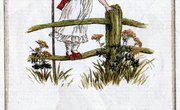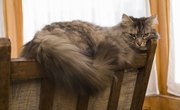A child with strong phonological awareness recognizes and manipulates the tiny units or sounds that make up spoken language. Comparing lengths of words and syllables is one component. Onsets, the consonants before the vowel in a syllable, and rimes, the vowel and consonants following it, require deeper phonological awareness. Preschoolers also need to recognize the individual sounds, called phonemes, in a word. Incorporate games to practice these skills that build oral communication and literacy.
Building Words
Preschoolers practice manipulating sounds by building or creating new words. One option to focus on phonemes -- the individual sounds -- is to have preschoolers smash the sounds together to make a word. Say the individual sounds of a word. For "dog," make the "d," "o" and "g" sounds individually with a slight pause between each. The students string the sounds together to figure out the word "dog." Another option is to create rhyming words to practice onset and rimes. Say two words that rhyme, such as "cat" and "hat." Ask preschoolers to create other words that rhyme. Nonsense words are acceptable; they show that the preschooler hears the rhyming sounds and can create new words that follow the same sound pattern.
Matching Sounds
Preschool students focus on sounds and parts of words in matching games. You can have students match rhyming words or beginning sounds. Collect several objects for this game. To practice matching, gather pairs of objects that rhyme, such as a hat and a small baseball bat or a stuffed-animal dog animal and a toy log. To practice onset, or beginning sounds, find objects that start with the same letter, such as a chain and a small chair for the "ch" sound. You can also use pictures of objects instead of using the actual objects. Hold up one object or picture. Ask a student to find another object or picture that either rhymes or starts with the same sound.
Syllable Challenge
Breaking words into syllables is a component of phonological awareness. This takes practice for preschoolers, especially when it comes identifying the syllables on their own. Introduce syllables by saying a word with a slight pause between syllables. Say "pen" and "cil" separately, for example. Preschoolers put the syllables together to determine the word; in this case, students would say "Pencil." To teach preschoolers to break down words, clap out the syllables as you say the word. For "pencil," clap twice -- once when you say "pen" and once when you say "cil." You can also have the students jump or do another action for each syllable.
Sound Search
Preschool books often include rhyming words and repeating sounds. Incorporate these books into a learning game. Identify rhyming words or repeated sounds in a story. For example, the story might use lots of words that start with the "b" sound or several words that rhyme with "book." Tell the preschoolers they need to be sound detectives as you read the book. Let them know which sound or rhyming word to find. When they hear it, have students do a particular action or movement, such as jumping up or raising their hands in the air.
Related Articles
References
Writer Bio
Based in the Midwest, Shelley Frost has been writing parenting and education articles since 2007. Her experience comes from teaching, tutoring and managing educational after school programs. Frost worked in insurance and software testing before becoming a writer. She holds a Bachelor of Arts in elementary education with a reading endorsement.











